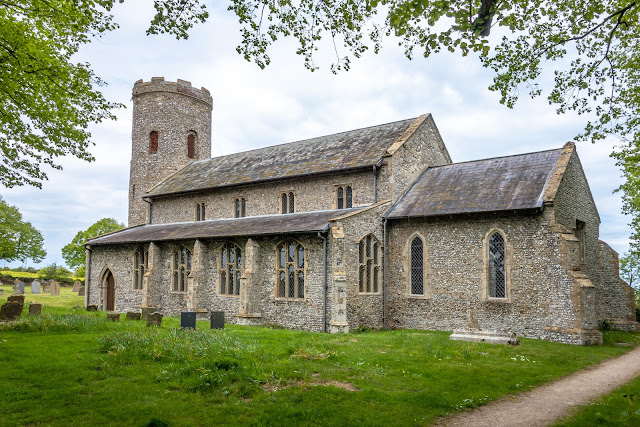Burnham Norton church and RSPB Titchwell
On our way from Wells to RSPB Titchwell, we stopped at the village Burnham Norton to have a look at the church of St Margaret. The church stands on a hilltop well south of the village it serves. In fact, it`s much closer to Burham Market than it is to Burnham Norton.
St Margaret's boasts a round west tower, and there is debate over just how old the tower is. Traditional historians date it to the Saxon period, but more recent surveys suggest a date somewhere around AD 1090, some 4 decades after the Norman Conquest. It could very well be that the church is Norman, but built by a Saxon mason using traditional techniques.

The oldest historic feature is a Norman font. The font is square, supported on a large central stem and four slender corner columns. It is comparatively plain; its sides are carved with blind arcading, chevron and diagonal crosshatch patterns, while the legs with chevrons, vertical stripes, and barley-twist style decoration. Unlike most Norman fonts, the legs are more richly carved than the font bowl.
Beside the church door is a small medieval wafer oven, looking like a stone cupboard
The real treasure of St Margaret's church is the wonderfully decorated hexagonal wine glass pulpit, which somehow escaped the worst efforts of the Reformation iconoclasts. But how did such obviously Catholic images escape destruction?
The painted panels are so richly coloured and in such good condition that the pulpit has been called the finest medieval example in England. The pulpit was the gift of the Goldalle family in 1450.
Four panels depict the 'four doctors' of the Church. These were not doctors in the sense of physical healers, but theologians whose writings were considered especially important in early Christian thought. For that reason each 'doctor' is shows with a quill pen and a manuscript.
One painted panel shows St Augustine regarding his pen, a manuscript on his lap. Another shows St Ambrose reading a scroll. A third panel depicts St Gregory writing on a scroll, and the fourth panel depicts St Jerome mending his quill pen. Curiously, St Jerome is shown wearing a Cardinal's hat, which did not exist at the time he was alive (c. 347-420). Obviously his likeness is very much medieval symbolism rather than any attempt at realism.
The final two panels show the donors responsible for the pulpit, Johannis (John) and Katherine Goldalle (Goodall). Perhaps John Goldalle was trying to buy spiritual favour by donating the pulpit, for local records show that he was arrested in 1446 for stealing oysters from the nearby salt marshes.
Looking past the Norman Font, it`s just possible to see the rather sorry remains of the rood screen and to appreciate the relative simplicity of this pretty little Norfolk church.
As for Titchwell? well, the only photo I took was this one of an Oyster Catcher. The day was definitely lacking in birds, and we were on our way home anyway!









Comments